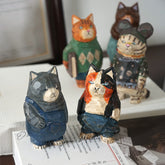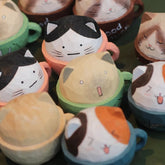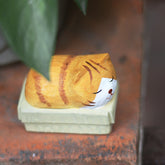Top 3 Carving Knife Skills for Crafting Wooden Gifts
Throughout the entire process of making wooden gifts, we repeat two actions that we call the basic carving methods of wood carving, namely, one is broaching, and the other is push carving.

Carving wooden gifts in the process of the three knife techniques
Pulling
Pulling as the name suggests is the action of the carving knife to pull back. Hold the carving knife in your hand with the back of the knife facing your thumb, then hold the carving knife with all four fingers and press your thumb against the front of your block of wood. Be careful to keep your thumb out of the path of the blade during the movement. Cutting backward as shown in the diagram is called pulling.


Push Carving
Push carving is different. With the back of the knife facing your thumb and your wrist reversed, use your left thumb to push the blade, i.e., push forward chipping. You can either use your thumb to push the back of the knife, or you can use your left thumb to push your right thumb, which is holding the knife. One thing to keep in mind with push carving is that your left index and middle fingers should not be within the path of the blade. We can understand that your thumb acts as a fulcrum while it applies the force forward.


Stopping the Engraving Mark
However, there is another scenario where we don't want to get to the bottom of everything we are cutting, such as when we are carving a figure's pants and need a stop mark.

This requires us to stop the knife at a fixed point, cut off the fibers of the wood, and then chip in to remove the unwanted pieces of wood. This concept is called a stop mark.


We repeat these three actions almost throughout the entire process of woodcarving: pushing, pulling, and cutting stop marks.
Does wood grain influence wood gifts?
After knowing the basic knife techniques of pulling and pushing, we need to understand a very important part of the process, which is the grain of the wood. The grain of the wood affects almost every step you take. We'll talk more about character carving later, and it's actually a good idea to consider the direction of the wood grain as you draw, and then remove the excess wood. If you're going to use a chisel, you need to watch the direction in which the wood grain goes deeper so you don't cut too much. It is then that you make the cuts with the carving knife. The wood grain has the strongest influence in this step.
To understand the effect of wood grain on the carving knife, we must first understand how wood grain is created and its patterns. We can imagine that the trunk of a tree is a bundle of straws from which nutrients and water from the ground are transported to the branches and leaves. The grain we see in the wood is the cut side of the straw, and the opposite side is its cross section. When splitting wood with an axe it will be easy to split with the grain, whereas it will be difficult to do so across the wood. Looking at the split wood its cross-section, we can see that the wood splits in irregular stripes. So, we are equivalent to making an opening with the blade of the axe, and the rest is actually propped up along the grain with our strength and the weight of the axe.
We can view this principle in the context of a carving knife; we go deeper with the carving knife in the direction of the grain, and the wood will probably not be able to withstand the incoming force and be split open in the same direction.

This is not the result we want. Conversely, chipping against the grain or perpendicular to the grain can circumvent this risk of splitting the wood. If you really can't tell the direction of the grain, especially on basswood where it's not obvious, you can try it with a carving knife and if the wood doesn't tend to split when you cut it down; if it does have such a tendency to split, you just need to cut it in a different direction. Or do not change the direction of the wood, will change the technique from push carving to pull cutting can be.












